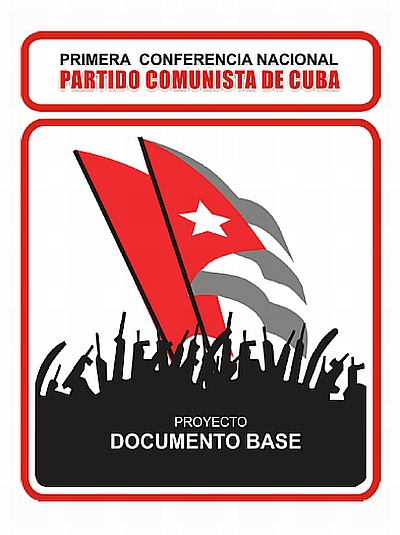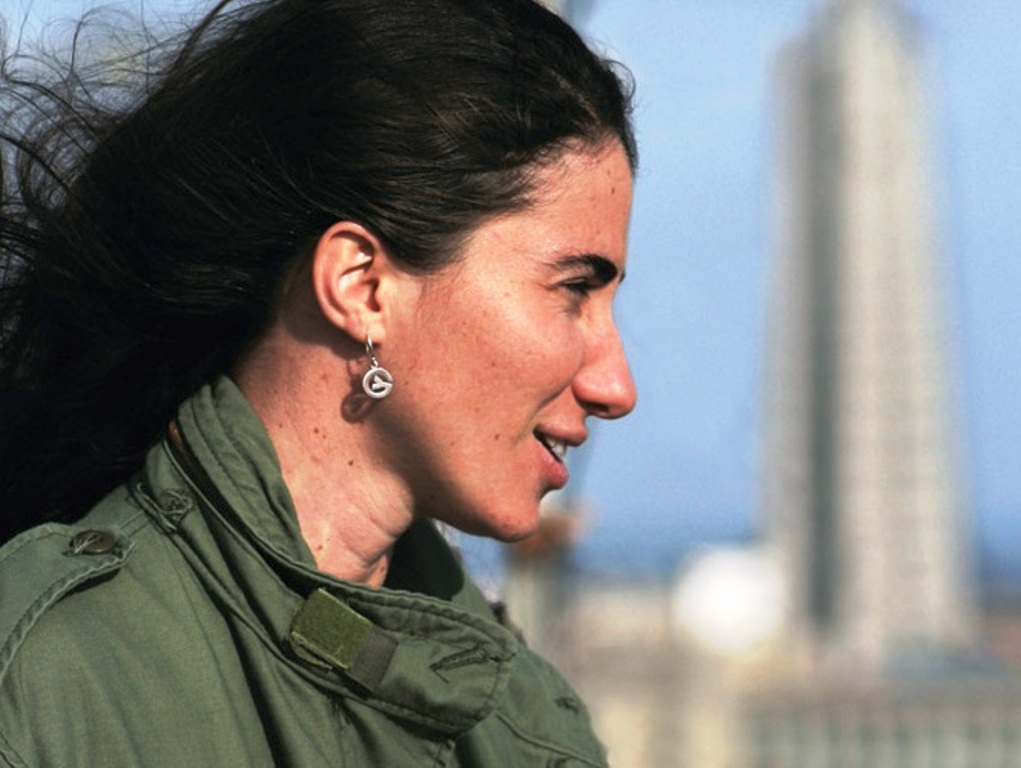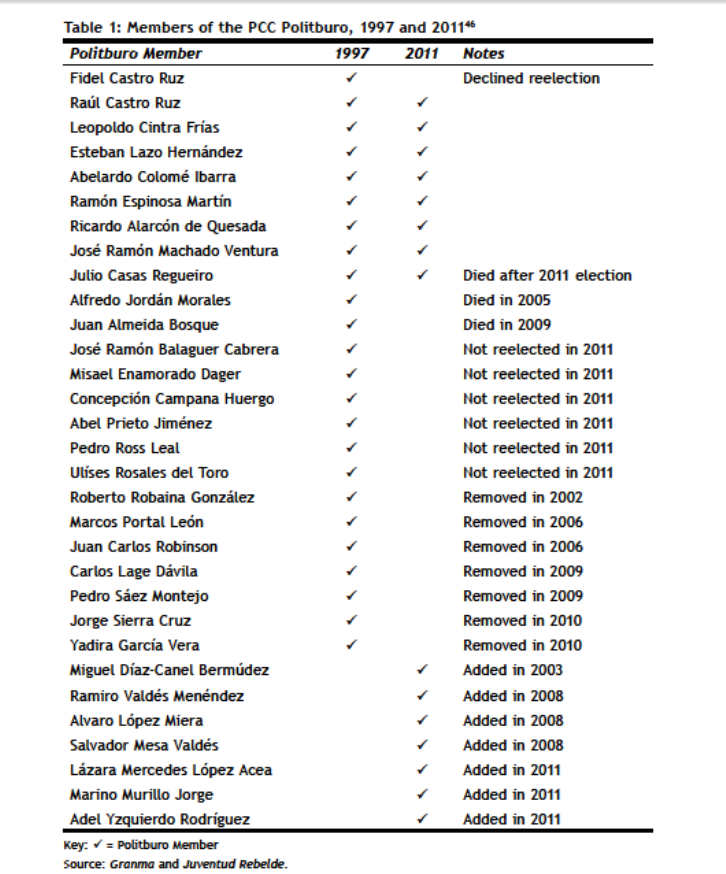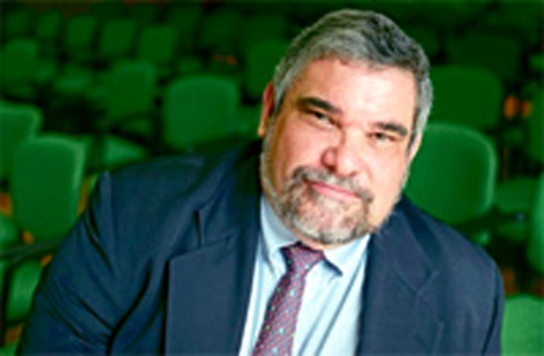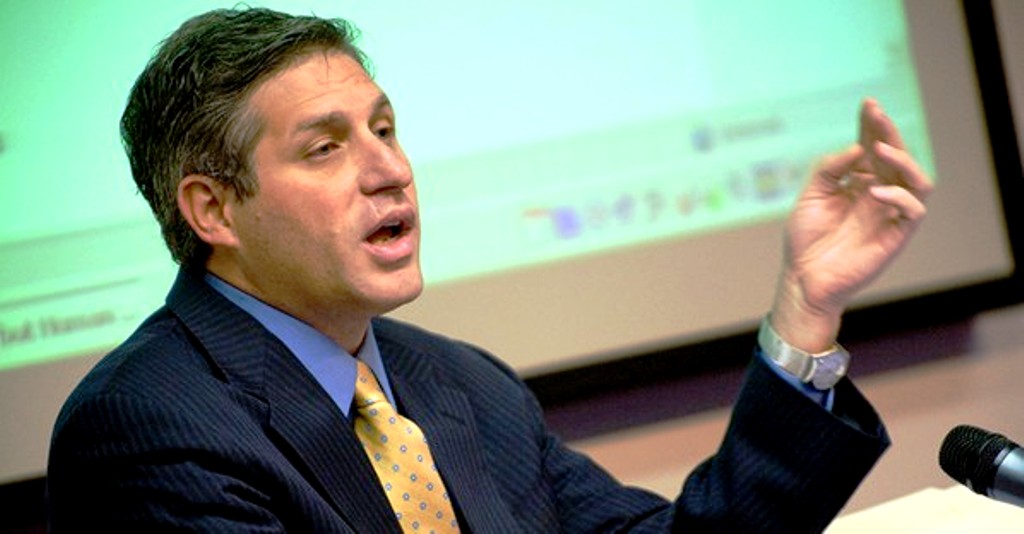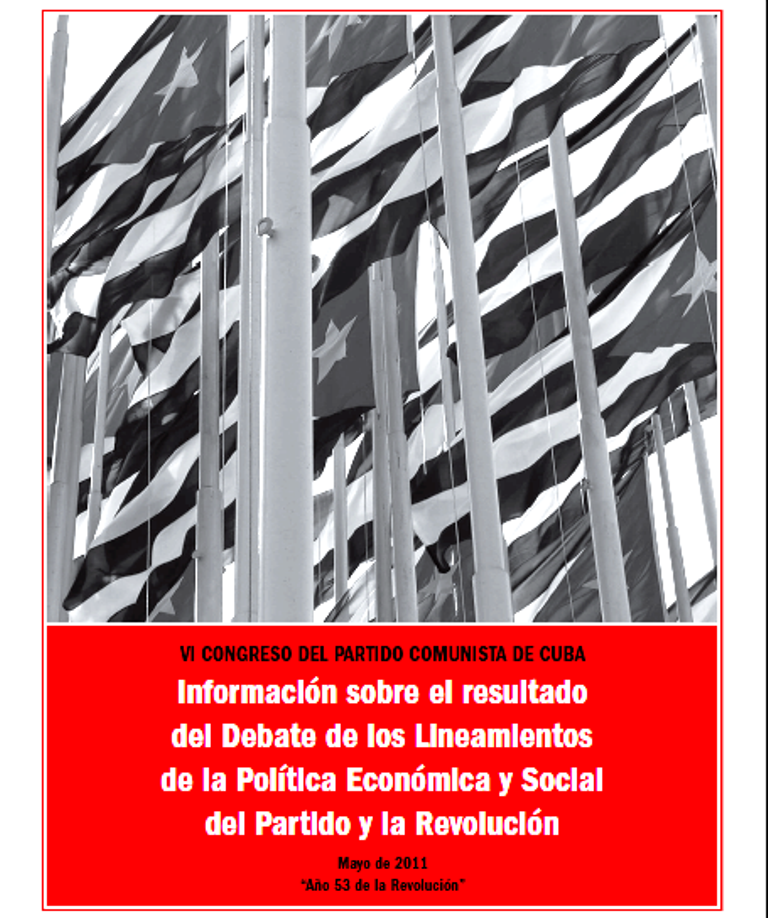Just Published on Espacio Laical, Suplemento Digital No.132 / 16 de Junio 2011
Tomado de la sección Búsqueda (revista 3-2011) Hyperlink here:

The Sixth Congress of the Cuba’s Communist Party will likely be of immense importance for Cuba’s future. The ratification of the revised Lineamientos de la Política Económica y Social del Partido y la Revolución “by the National Assembly means that it is now politically correct to support, advocate and implement an ambitious reform agenda. By implication, it also is politically correct to draw the conclusion that a half century of economic experimentation with the lives of Cuban citizens was for the most part misguided, counterproductive, and unsustainable. Despite attempts to create an impression of historical continuity by referring to the “updating” of the economic model, the old approaches to economic management have been deeply discredited. The shifting climate of opinion regarding how the Cuban economy can best function has been certified as reasonable by the National Assembly. It now appears that a regression to old modes of economic operation is now highly improbable..
The economic future for Cuba clearly lies in a newly-rebalanced albeit vaguely-envisaged mixed market economy that will be the outcome of the various reforms that are slated to be implemented. This is a surprising reversal of fortunes. It also constitutes a vindication of the some of the views of the critics of past economic policies.
The “Lineamientos” represent an attempt by President Raul Castro to forge his own “legacy” and to emerge from the long shadow of his brother, as well as to set the Cuban economy on a new course. The ratification of the reform agenda represents a successful launch of the “legacy” project. President Raul Castro would indeed make a unique and valuable contribution to Cuba and its citizens were he to move Cuba definitively through dialogue and agreement among all Cubans towards a model that guarantees both economic and social rights as well as civil liberties and authentic democracy.
Are moves in these directions likely to happen? Not under current political circumstances. However, there are bottom-up pressures building and some official suggestions that movement towards political liberalization is not impossible. In the meantime, Raul’s de-centralizing, de-bureaucratizing and “market-liberalizing” reforms been launched. This is a good start for the construction of a positive independent “legacy.”
I. Cuba’s Economic Situation
In various speeches since 2006, Raul Castro has indicated that he recognizes the problems that Cuba confronts in terms of the production of agricultural and industrial goods and improvement of Cuba’s infrastructure (despite the ostensibly solid GDP performance from 2005 to 2009 before Cuba was hit by the international recession.) He is well aware of the central causal forces underlying weak Cuba’s economic vulnerabilities and weaknesses such as the unbalanced structure of the economy, the overburden of deadening rules and regulations and a sclerotic bureaucracy and the monetary and exchange rate pathologies and dysfunctional incentive environment that deform the energies and lives of Cuban citizens.
Cuba’s economic plight can be summarized quickly with a couple of illustrations. First, Cuba’s underwent serious de-industrialization after 1989 from which it has not recovered, reaching only about 51% of the 1989 level by 2009 (Chart 1)
 Source: ONE AEC, 2004, Table 11.1 and 2IX.1
Source: ONE AEC, 2004, Table 11.1 and 2IX.1
Note: Data for 1990-1997 are not available
There are a variety of reasons for the collapse of the industrial sctor:
(a) The antiquated technological inheritance from the Soviet era as of 1989;
(b) Insufficient maintenance over a number of decades before and after 1989;
(c) The 1989-1993economic melt-down;
(d) Insufficient levels of investment; (The overall level of investment in Cuba in 2008 was 10.5% of GDP compared to 20.6% for all of Latin America according to UN ECLA, 2011, Table A-4.)
(e) The dual monetary and exchange rate system that penalizes potential exporters that would receive one old (Moneda Nacional) peso for each US dollar earned from exports;
(f) Competition in Cuba’s domestic market with China which has had a grossly undervalued exchange rate, coexisting with Cuba’s grossly overvalued exchange rate.
Second, the collapse of the sugar agro-industrial complex is well known and is illustrated in Chart 2. The sugar sector essentially was a “cash cow” milked to death for its foreign exchange earnings, by insufficient maintenance, by insufficient re-investment preventing productivity improvement, and by the exchange rate regime under which it labored.
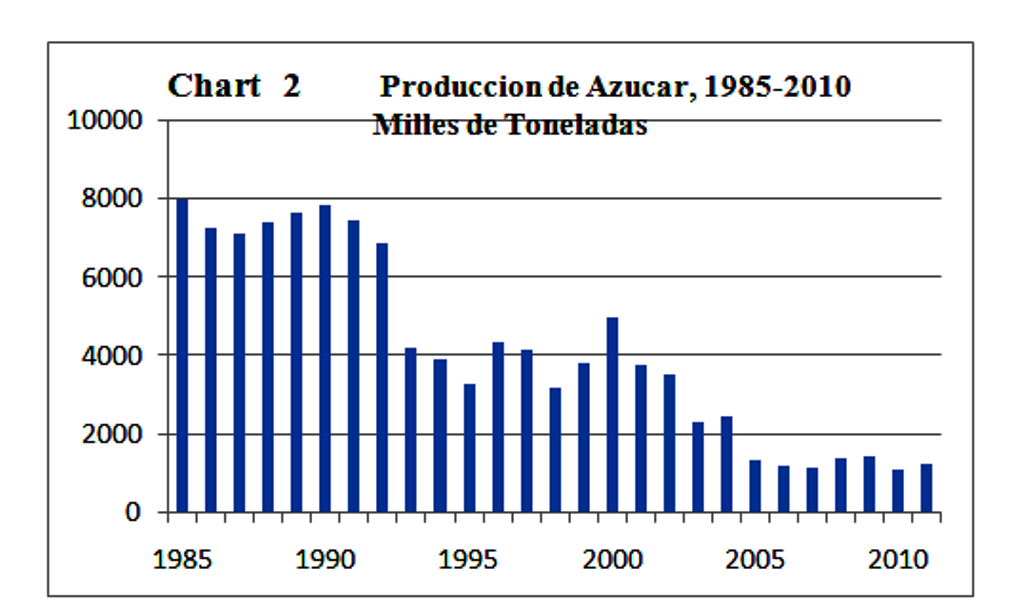 Source: NU CEPAL, 2000 Cuadro A.86; ONE, 2010 Table 11.4
Source: NU CEPAL, 2000 Cuadro A.86; ONE, 2010 Table 11.4
The consequences of the collapse of the sugar sector include the loss of about US$ 3.5 billion in foreign exchange earnings foregone (generated largely with domestic value added); reductions in co-produced electricity; a large increase in idled farm land; a destruction of the capacity to produce ethanol; damaging regional and local development impacts, and a destruction of much of the “cluster” of input-providing, output-processing and marketing activities related to sugar.
Third, the production of food for domestic consumption has been weak since 1989, despite some successes in urban agriculture. Food imports have increased steadily and in recent years account for an estimated 75 to 80% of domestic food consumption despite large amounts of unused farm land. Meanwhile agricultural exports have languished,
Chart 3 Cuban Exports and Imports of Foodstuffs, 1989-2009
(excluding Tobacco and Alcoholic Beverages) (Millions CUP)
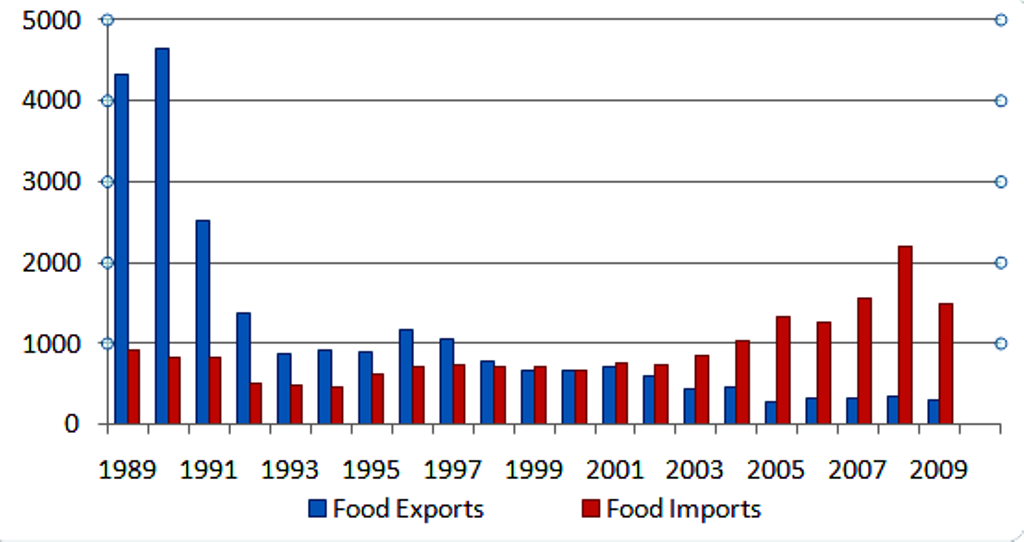 Source: NU CEPAL, 2000 Tables A.36 and A.37, and ONE, AEC, Various Years.
Source: NU CEPAL, 2000 Tables A.36 and A.37, and ONE, AEC, Various Years.
Fourthly, “inflation-adjusted “ or “real” wages in the official economy collapsed and have not recovered significantly according to estimates from the Centro de Estudios sobre la Economia Cubana (Chart 4.) This is indeed a major calamity for the official state economy. But though the official 2008 wage rate remained around 25% of its level of 1989, most people had other sources of income, such as remittances, legal self-employment, home produced goods and services, economic activities in the underground economy, income supplements in joint ventures, goods in kind from the state and widespread pilferage. Those without other sources of income are in poverty.
Chart 4 Cuba: Real Inflation-Adjusted Wages, 1989-2009
(Pesos, Moneda Nacional)
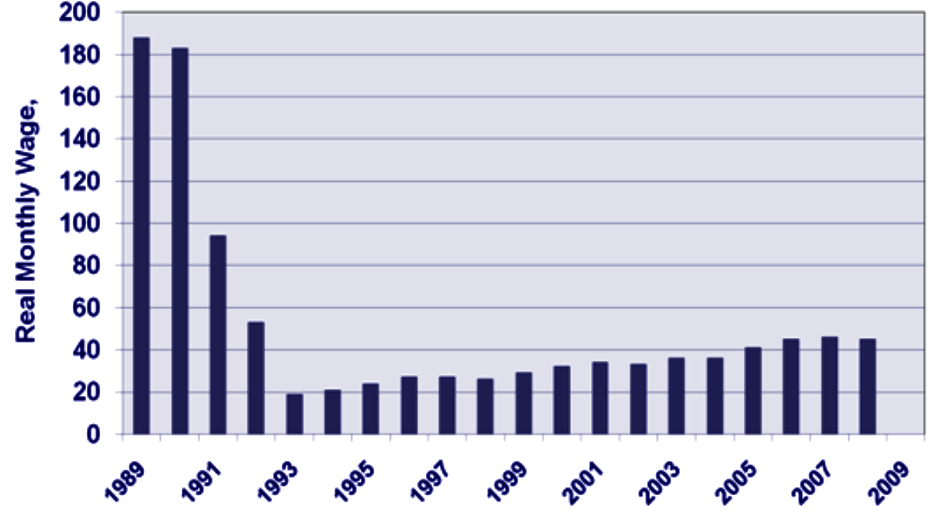 Vidal Alejandro, Pavel, “Politica Monetaria y Doble Moneda”, in Omar Everleny Perez et. al., Miradas a la Economia Cubana, La Habana: Editorial Caminos, 2009
Vidal Alejandro, Pavel, “Politica Monetaria y Doble Moneda”, in Omar Everleny Perez et. al., Miradas a la Economia Cubana, La Habana: Editorial Caminos, 2009
Furthermore, despite the exceedingly low official rates of unemployment – around 1.6 to 1.7%, (far below the “natural rate” of unemployment which represents normal new entrants, job-changers and structural changes in any economy) – underemployment is obviously very high. Presumably the 1.8 million workers considered by the Government to be redundant and subject to probable lay-off and transfer to small enterprise, are “underemployed”, accounting for around 35 per cent of the labor force.
A further dimension of the fragility of Cuba’s economic situation is the dependence on the special relationship with Venezuela that relies upon high oil prices and the presence and munificence of President Chavez.
It is to the credit of President Raul Castro that he has faced these problems directly, diagnosed their sources, and produced the “Lineamientos” to deal with them. The central sources of the difficulties are the general structure of incentives that orients the economic activities of Cuban citizens, this including the dual monetary and exchange rate system, the tight containment of individual economic initiatives, the detailed rules and regulations of the omnipresent bureaucracy. Paradoxically, in attempting to control everything in the past, the government has ended up controlling very little. The effectiveness of stricter state controls actually leads to weaker genuine control due to their promotion of illegalities, corruption and the ubiquitous violation of unrealistic regulations.
II. The Lineamientos
The objective of the “Lineamientos” is “to guarantee the continuity and irreversibility of Socialism” as well as economic development (p.10). This is to be achieved through an “up-dating” of the economic model that should result in utilization of idle lands, reversal of decapitalization of infrastructure and industry, a restructuring of employment, increased labor productivity, increased and diversified exports, decentralized decision-making and elimination of monetary and exchange rate dualism (p. 8.)
But the term “Socialism” remains somewhat ambiguous in the document. Reference is made to “socialist property” and “preserving the conquests of the Revolution.” Especially interesting is the statement that
“…socialism signifies equality of rights and equality of opportunities for all the citizens, not egalitarianism” (p.9)
This assertion could be of game-changing significance, as it articulates a fundamental principle of “Social Democracy” more so that a traditional principle of “Socialism.” This leaves questions unanswered and doors unclosed.
The “Lineamientos” are in effect an ambitions and comprehensive “wish-list” or statement of aspirations. Many of the 313 recommendations are fairly obvious, trite and general statements of reasonable economic management. Some statements have been made repeatedly over a number of decades, including those relating to the expansion and diversification of exports, science and technology policy, the sugar agro-industrial complex, or the development of by-products and derivatives from the sugar industry (an objective at least since 1950.) Restating many of these as guidelines can’t do much harm, but certainly does not guarantee their implementation.
There are also opaque elements among the guidelines and seeming contradictions as some of them stress continuity of state planning and control while others emphasize greater autonomy for enterprises. For example, Guideline 7 emphasizes how “planning” will include non-state forms of enterprise and “new methods…. of state control of the economy” while No. 62 states “The centralized character …of the degree of planning of the prices of products and services, which the state has an interest in regulating will be maintained.” But numerous other guidelines spell out the greater powers that state and non-state enterprises will have over a wide range of their activities including pricing (Guidelines 8 to 22 and 63.)
While there are a few gaps and shortcomings in the “Lineamientos” as well as the references to planning and state control, they include some deep-cutting proposals on various aspects of economic organization and policy that represent the inauguration of a movement towards a “market-friendly” economic policy environment. Among these are:
- Greater autonomy of the enterprise in numerous dimensions, hiring and firing, wage structures, financing, price setting, investing, and also in facing bankruptcy;
- A phase-out of rationing and the ration book and the more careful targeting of social assistance to those who need it, thereby also strengthening incentives to work (No. 162);
- The establishment of wholesale markets for inputs for all types of enterprise. (No. 9);
- Continuing distribution of unused state lands to small farmers (No. 187);
- Reduction of state controls regarding small farmers and cooperatives regarding producer decision-making, marketing of crops, provision of inputs, and (No. 178-184)
A central policy thrust is the expansion of the self-employment and cooperative sector in order to absorb ultimately some 1,800.000 state workers considered redundant. The legislation already implemented in October 2010 liberalized policy somewhat so as to encourage the establishment of additional microenterprises – especially by the liberalization of licensing, the establishment of wholesale markets for inputs and the recent relaxation of hiring restrictions. However, the limitations of the policy changes are highlighted by the modest increase in the number of “Paladar” chairs – from 12 to 20.
Unfortunately current restrictions will prevent the expected expansion of the sector. These include the heavy taxation that can exceed 100% of net earnings (after costs are deducted from revenues) for enterprises with high costs of production; the prohibition of the use of intermediaries and advertising, and continued petty restrictions. Perhaps most serious restriction is that all types of enterprises that are not specifically permitted are prohibited including virtually all professional activities. The 176 permitted activities, some defined very narrowly, contrast with the “Yellow Pages” of the telephone directory for Ottawa (half the size of Havana) that includes 883 varieties of activities, with 192 varieties for “Business Services”, 176 for “Home and Garden, 64 for “Automotive” and 29 for “Computer and Internet Services.” Presumably policies towards micro-and small enterprise will be further liberalized in the months ahead if laid-off workers are to be absorbed productively.
One short-coming of the “Lineamientos” is the lack a time dimension and a depiction of how the various changes will be implemented. There are no clear priorities among the innumerable guidelines, no sequences of actions, and no apparent coordination of the guidelines from the standpoint of their implementation. It remains a “check-list” of good intentions, though none-the-less valuable.
The absence of a vision of how change was to occur and the slow pace of the adoption of the reforms so far is also worrisome. However, the Administration of Raul Castro has been deliberative and systematic though also cautious. It is probable that somewhere in the government of Raul Castro there is a continually evolving time-line and master-plan for the implementation of the reform measures.
A careful and well-researched approach to economic reform is obviously desirable. The difficulties encountered in laying off 500,000 state sector workers and re-absorbing them in the small-enterprise sector by March 31, 2011 has probably encouraged an even more cautious “go-slow” approach. Perhaps “slow and steady wins the race!”
A process of economic —but not political— reform seems to have already begun following the Congress. Where it will lead is hard to predict. Presumably Raúl Castro’s regime would like the process to end with the political status quo plus a healthy economy. The latter would require a new balance between public and private sectors, with a controlled movement toward the market mechanism in price determination and the shaping of economic structures, and with the construction of a rational configuration of incentives shaping citizens’ daily economic actions so that their private endeavors become compatible with Cuba’s broader economic well-being.
In such a reform process many things would be changing simultaneously with symbiotic impacts and consequences that will likely be painful and are difficult to foresee. Will President Raul Castro have the courage to take the risks inherent in an ambitious process of economic change? This remains to be seen. But the economic and political consequences of inaction are so bleak and the attractiveness of a positive historical “legacy” are so enticing that President Raul Castro will continue.
The economic reform process has been launched. It is in its early stages. It will likely continue under the leadership of Raul Castro. It will proceed far beyond the “Lineamientos” under new generations of Cuban citizens in economic as well as political spheres.
Bibliography
Naciones Unidas, CEPAL, La Economia Cubana: Reformas estructurales y desempeňo en los noventa, Santiago, Chile, 2000, Second Edition.
Oficina Nacional de Estadisticas (ONE), Anuario Estadistico de Cuba (AEC), various years. Website: http://www.one.cu/
Partido Comunista de Cuba, Lineamientos de la Política Económica y Social del Partido y la Revolución, Aprobado el 18 de abril de 2011, VI Congreso del PCC
United nations, Economic Commission for Latin America and the Caribbean, Preliminary Overview of the Economies of Latin America and the Caribbean, 2010, Santiago, Chile January, 2011
Vidal Alejandro, Pavel, “Politica Monetaria y Doble Moneda”, in Omar Everleny Perez et. al., Miradas a la Economia Cubana, La Habana: Editorial Caminos, 2009



